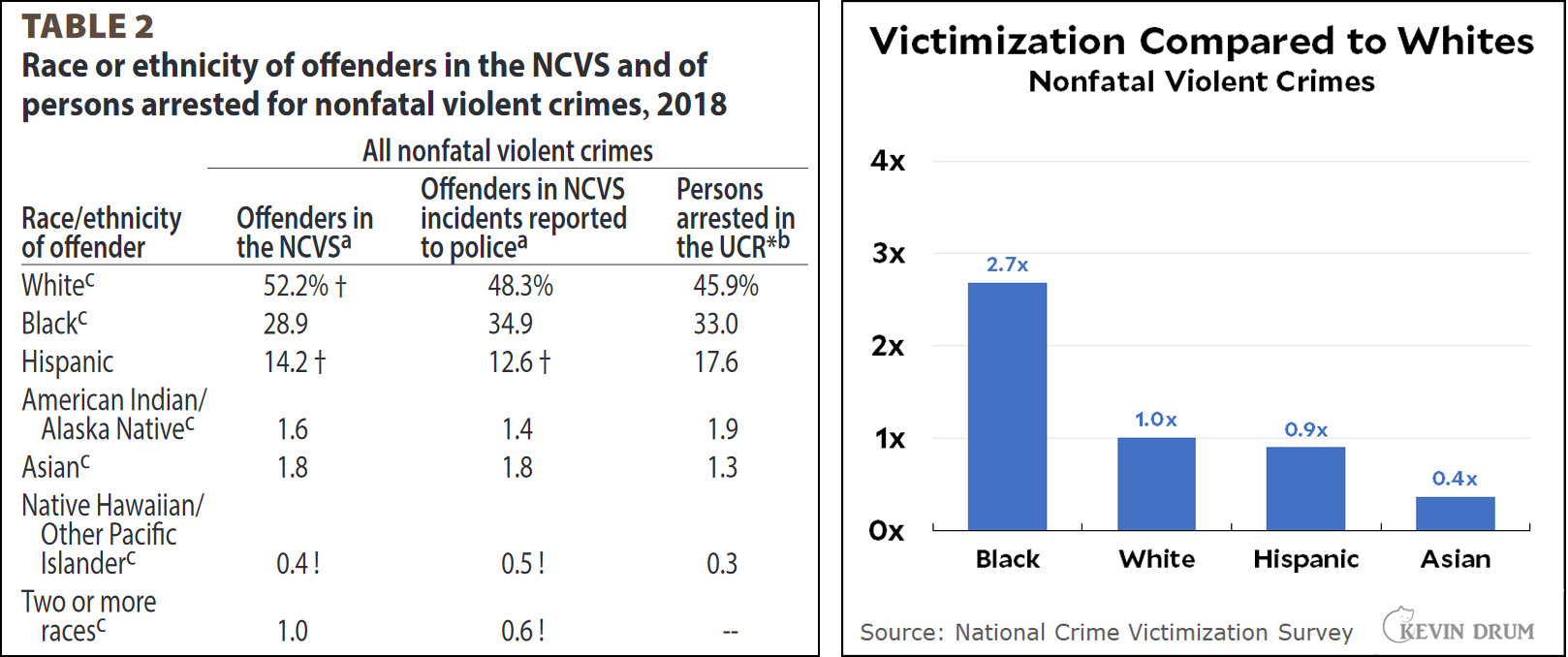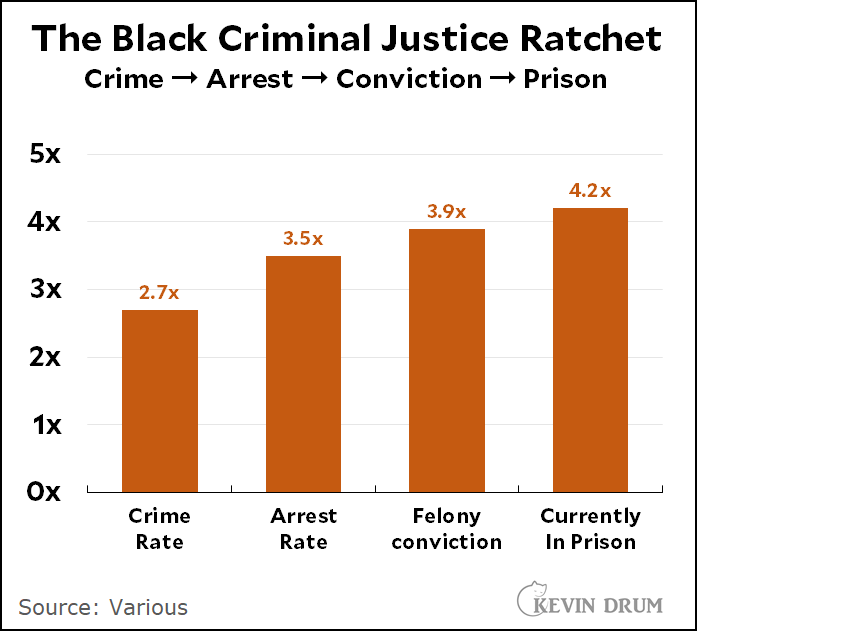What is the underlying rate of Black crime vs. white crime? This is a tricky question to answer, but recently the Bureau of Justice Statistics took a crack at it in "Race and Ethnicity of Violent Crime Offenders and Arrestees, 2018." Their basic results boil down to two tables, the first of which is derived from the FBI's Uniform Crime Reporting. It's below on the left:

Table 1 shows that Black people account for 33% of arrests for nonfatal violent crimes compared to a 12.5% share of the population. A little arithmetic produces the chart on the right, which shows that Black people are arrested at about 3.5x the rate of white people.
The problem with arrest rates is that they might not represent the underlying crime rate. Instead, it's possible that Black and white crime rates are similar but racist policing policies produce more arrests of Black people.
But there's another way of looking at this. The National Crime Victimization Survey also estimates crime rates, but police aren't involved. It's a simple survey that asks people if they've been the target of a crime during the past year.
Now, there are obvious limitations to the NCVS. For starters, you can't call up people to ask if they've been murdered, so there are no homicide numbers. You also can't ask about race for most property crimes, since the victim of, say, a home burglary never sees the thief. That leaves violent crime other than murder, which is why the measure used here is "nonfatal violent crime."
That said, it's still a pretty useful measure. It's below on the left:

Again, a bit of arithmetic shows that survey respondents report being victimized by Black people at 2.7x the rate of white people. This is close to the arrest rate reported by the FBI even though it uses an entirely different methodology. That suggests the true underlying violent crime rate for Black people is in the ballpark of 3x that of white people.
However, at every step of the way the criminal justice system makes this worse. A careful study done in 2017 concludes that the lifetime Black felony conviction rate is 3.9x higher than the white rate. And a report from the Bureau of Justice Statistics says that Black people are currently imprisoned at a rate 4.2x higher than white people.
These are not all precisely comparable numbers. The 2017 study only goes through 2010 and includes all offenses, not just violent crime. The BJS report is for 2018, but it also includes all crimes. Nevertheless, these are relatively minor differences. Here's how the whole thing looks, with each number representing the Black rate as a multiple of the white rate:

It's wise not to put too much faith in the precise value of each of these numbers, but the trend is obvious. By the time the ratchet is finished, the Black community is in prison at a proportion that's half again larger than their underlying crime rate.

An intriguing gap here is how much Race/Ethnicity correlates to Economic Status.
I would suspect that if one had the data granularity to break out this data not only by Race/Ethnicity but also by income levels (and geographically to living in low-income / impoverished neighborhoods) that one would likely see weaker racial-ethnic associations versus income level or income-community associated crime experience. Of course weaker is not to hypothesize none.
But based on comparative history (including US white ethnics as immigrant underclasses) one must suspect that a good bit of this racially mapped results here are disguising a class (or class-to-caste) socio-economic experience.
And even here, you would need to consider a "nearest neighbor" effect. Not only how it correlates with income, but the income of their neighbors.
I'm specifically thinking of the question, "Do poor blacks buy more Air Jordans than poor whites?" (or some equivalent for poor whites) And I remember a study a number of years back that concluded, yes, they do, *but* the effect goes away when you look at neighbors income levels. Poor whites who lived near other poor people would buy just as much "luxury goods" as poor blacks, it's just that poor whites were more likely to live near richer (mostly) whites. And there's no sense buying Air Jordans as a status symbol if your neighbor is driving a Lexus.
I certainly see this in my own town of St. Louis. White neighborhoods appear to be more mixed income, whereas poor black neighborhoods appear more monolithic. And I'm imagining that the mixed income neighborhoods are overall safer.
At any rate, there's deeper levels reflecting decades of inequity that are probably at play here as well.
Right - that's why I evoked the geographical angle - not merely income level of the individuals, but whether they are living in a geographical area that is concentrated poverty or more mixed income. That seems very likely to have multiple effects - greater crime exposure, victimization, different impacts on socialization.
And of course segregation / redlining clearly has a likely impact there.
This thought also bounced around in my head. Often I wonder if economic factors are represented in what is shown as possible race/ethnic issues when these discussions occur.
One has to suspect quite a lot.
Not 100% certainly - but often when I read a profile of issues faced by black Americans etc (health care, etc), many items evoked seem to me to be perhaps majority economic but with a negative booster of racial aspects to the cocktail.
(of course one should not jump from that to seeing the challenges as solely economic à la Bernie)
For that reason it's smart probably to address many racial challenges via programs that also touch on poor whites, to give a bridge to buy-in... I have the sentiment that there are lost opportunities there regrettably due to the adoption of very Idententarian discourse
...Just as there are massive lost opportunities by ignoring racism to focus on class.
I rather doubt the current Left is missing any actionable opportunities presently in focusing on class since the Identarian Lefty-culty activist wing has so loudly taken over.
Noting I am not a Bernie Bro and I thought his 1960s Left schtick focus on economic with black voters was stupidly tone deaf.
"By the time the ratchet is finished, the Black community is in prison at a proportion that's half again larger than their underlying crime rate."
A fair conclusion based on an objective analysis. And this doesn't even include the effects of current and historical socio-economic conditions. As the title of a Washington Post article by Jonathan Capehart says "Being Black in America Is Exhausting."
Can this be broken down a step further,
What is the arrest rate of lower middle class, working class and poor white people for violent crime compared compared to lower middle class, working class and poor black people?
What I was getting at above.
One suspects that working / poor whites and blacks face similar issues - although doubtless 'visible minorities' will have it worse. Of course it probably needs attention to the geography - concentrated poverty geographies versus more mixed income with the former likely generating more crime experience (which would have a a likely further ethno-racial impact via segregation of housing).
That is an excellent point about the nearest neighbors and general expectations and it's a strong argument in favor of breaking up low-income neighborhoods, despite popular resistance.
It's easier to do it by 'breaking up' segregated or high-income areas.
A shelter in every neighborhood... there should also be apartments in every neighborhood, too.
Easier in the fictional Lefty Culty white liberal world where opposition to said shelters did not generate fierce local opposition as Drum has highlighted many times in the past (shelters in any case is homelessness not poverty-level working class, funny how the Lefty Culty mix those two as if they're the same thing)
Magical thinking.
On a related topic, there is research indicating that race of victim is a critical factor in the imposition of the death penalty (as you might guess, it is imposed most often when the decedent is white). Race of offender was also statistically significant, but not nearly as pronounced as race of victim. I believe it was used in Supreme Court cases challenging the constitutionality of the death penalty, and is probably a couple of decades old now.
I've been thinking a lot about the role of class in all of this. Not as an "aha, there's no racism!", but more as a way in which we are signfiicanly overlooking an opportunity for solidarity.
For example, what percentage of "trivial" interactions with cops happen with folk below median income, such as expired tags, etc. I'm guessing it's much higher than 50%. What if we started to draw up police practices with this in mind? Such as ending a lot of them, but also what about saying, no lethal weapons on a cops body for such stop, or for wellness checks, etc.?
This should be underlying REPORTED crime rate. While there may be no difference there, it's also possible that maybe there is.
Basically, what if there's a reporting or racial component that leads to that 2.7x crime rate to begin with? Not to mention other non-racial factors (or at least not directly racial) which I think are hinted at here, like socioeconomic status.
"... By the time the ratchet is finished, the Black community is in prison at a proportion that's half again larger than their underlying crime rate."
You are assuming that the ratio between the black and white crime rates is independent of how serious the crime is. Actually the ratio tends to increase for more serious crimes (that get more prison time). Which explains the greater proportion in prison.
Pingback: The Problem of Police Racism (II) | Tony-Greco.com